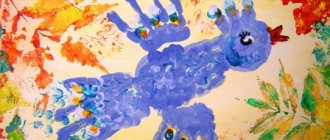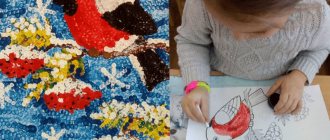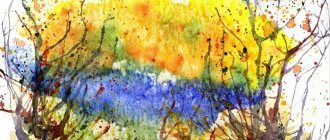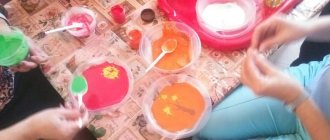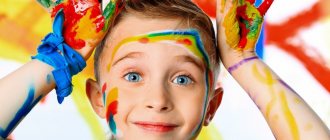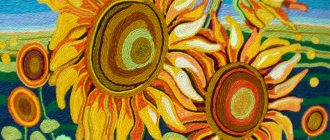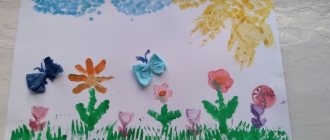MAGAZINE Preschooler.RF
Self-education plan for the 2020–2021 academic year on the topic: “Non-traditional drawing techniques”Middle group Teacher of the 1st category: Atnagulova Nailya Galievna
Self-education plan on the topic: “Drawing with non-traditional techniques” (middle group) for the 2021 – 2021 academic year.
Goal: to develop children's creative abilities through non-traditional drawing.
Objectives of self-education work:
- Study the literature on this topic.
- Familiarization with innovative technologies using non-traditional drawing techniques.
- Draw up a work plan on this topic.
- Prepare consultations for parents on this topic.
- To form knowledge in children of middle preschool age about non-traditional methods of drawing;
- Teach students to independently use non-traditional drawing techniques;
- To develop children's creative abilities, fine motor skills, thinking, imagination, attention, perseverance.
- Cause an emotional response to a new way of drawing, a desire to experiment.
Studying methodological literature:
- R. G. Kazakova “Drawing classes with preschoolers: non-traditional techniques, planning. Lesson notes" . - M: T. Ts. Sfera, 2005.
- G. N. Davydova “Non-traditional drawing techniques in kindergarten .
M.: “Publishing house Scriptorium 2003” , 2014.
3. I. A. Lykova “Art activities in kindergarten” middle group
4. T. S. Komarova “Classes in visual arts” middle group
5. Nikitina A.V. Non-traditional drawing techniques in kindergarten - St. Petersburg: “KARO” 2007.
6. Electronic resources.
Relevance of the chosen topic:
Teaching children to draw using non-traditional techniques is interesting and exciting! Drawing with non-traditional techniques liberates children and allows them not to be afraid of doing something wrong. Drawing with unusual materials and original techniques
allows children to experience unforgettable positive emotions.
Emotions are both a process and a result of practical activity—artistic creativity. Drawing using non-traditional image techniques does not tire preschoolers; they remain highly active and efficient throughout the entire time allotted for completing the task. Non-traditional techniques allow for an individual approach to children, taking into account their desires and interests. Non-traditional drawing techniques are the most important matter of aesthetic education; these are ways to create a new, original work of art in which everything is in harmony: color, line, and plot.
An unconventional approach to creating images gives impetus to the development of children's intellect, encourages the child's creative activity, and teaches him to think outside the box. New ideas arise related to combinations of different materials, the child begins to experiment and create.
Non-traditional drawing techniques are a real flame of creativity, it is an impetus for the development of imagination, the manifestation of independence, initiative, and expression of individuality
The path to creativity has many roads for them, known and still unknown. Creativity for children is a reflection of mental work. Feelings, mind, eyes and hands are the instruments of the soul. The creative process is truly a miracle. “In creativity there is no right way, there is no wrong way, there is only your own way.”
A long-term plan for working with children and parents on the topic “Non-traditional drawing techniques”
month
| Topic, purpose | Working with parents | |
| September | “Apple tree” (painting using the poking method, imprint with a cork) Goal: Continue to learn how to draw using the poking method, strengthen the ability to hold a brush correctly. Strengthen your drawing skills using cork. “Amanita” (drawing with cotton swabs) Goal: Continue learning to draw with cotton swabs. Develop fine motor skills, imagination, aesthetic taste. To cultivate accuracy, hard work, and composure when performing work techniques. | Questioning parents on the topic: “Determining a child’s interest in visual arts” |
| October | “Autumn tree” (leaf print) Goal: To teach children to work with fragile material - leaves. Develop a strong interest in drawing and imagination. Cultivate neatness “Clouds ran across the sky, birds were sent on a long journey” (drawing with crumpled paper) Purpose: To introduce the technique of drawing with crumpled paper. Cultivate accuracy when working with paints, develop fine motor skills | Folder movement "The miracle of unconventional painting techniques" |
| November | "Handkerchief Decoration" (finger painting, cork printing) Goal: Learn to decorate a handkerchief with a simple pattern using printing, finger painting, develop a sense of composition and ri. (drawing with a foam sponge) Goal: To help children master a new way of depicting - drawing with a foam sponge, which allows you to most clearly convey the depicted object, the characteristic texture of its appearance, and position the image in accordance with the size of the sheet | |
| December | “Let’s decorate the Christmas tree” (painting using the poking method, finger painting) Purpose: To practice the technique of drawing with a poke, semi-dry hard brush. Strengthen the ability to decorate a picture using finger painting. To develop in children the ability to work individually. "Bullfinch" (drawing using the poke method) Goal: To form in children a generalized idea of birds, to awaken interest in famous birds, and to practice drawing bullfinches using the poking method. | Consultation for parents: “Organization of independent visual arts activities for children” |
| January | "Fairy-tale world of illustrations" (poke with a hard brush) Goal: To expand children’s understanding of the work of illustrators, to show the features of the depiction of furry animals by E. Charushin, to teach children to depict the fluffy fur of animals. “The snow is spinning” (drawing with crumpled paper) Goal: Improve the ability to draw a hedgehog with crumpled paper, develop a sense of rhythm and composition. Cultivate neatness. | Wall newspaper for parents “We love to draw” |
| February | “Tie for Dad” (tamponing) Goal: Continue practicing the tamponing technique, develop a sense of composition and color. “Boat” (drawing with cotton swabs) Goal: Continue to introduce the technique of drawing with cotton swabs. Develops fine motor skills and tactile perception; develops creative abilities. | |
| March | "Beautiful flowers for mom" (painting with palm and fingers) Goal: Continue to learn how to draw with your palm and finger on a sheet of paper; Reinforce your knowledge of red and green colors; Develop imagination; Cultivate neatness “Sun” (painting with palms) Goal: To develop in children the ability to draw in an unconventional technique using the “palm” (rays of the sun). Strengthen children's knowledge about the color yellow. Develop creative abilities. Cultivate accuracy in work. | Joint creativity of a child and a parent Exhibition of drawings “Magic Palms” |
| April | “Fish” (palm drawing) Goal: Continue to introduce children to the technique of palm drawing. Develop creative imagination, attention, fine motor skills and hand coordination. “Starry sky” (foam rubber stencil printing) Goal: Learn to create an image of the starry sky using mixing colors and stencil printing. Develop color perception. Practice drawing using these techniques | Consultation for parents: “Drawing is important!” |
| May | “Salute” (wax crayons, gouache) Goal: Strengthen the skill of drawing gouache, learn to draw fireworks using wax crayon. Develop a sense of rhythm and composition, fine motor skills. “Colorful butterflies” (monotopy) Goal: To introduce the monotype technique, consolidate the ability to use the “old form, new content” monotype technique. Introduce children to symmetry using the example of a butterfly. | Exhibition of children's drawings. |
| < Previous | Next > |
Self-education plan for a kindergarten teacher. Unconventional drawing techniques
Self-education plan for a preschool teacher
Topic : Non-traditional drawing techniques in older preschool age. Goals: - To develop the ability to implement acquired knowledge about means of expression in one’s own creativity; — Develop the ability to perform a collective composition, coordinate your actions with peers; — Develop the need to create a new, unusual product of creative activity; — Develop aesthetic appreciation and the desire for creative self-realization. Objectives: - expand the understanding of the variety of non-traditional drawing techniques; — to form an aesthetic attitude to the surrounding reality based on familiarization with non-traditional drawing techniques; - to form aesthetic taste, creativity, imagination; - develop associative thinking and curiosity, observation and imagination; — improve technical and drawing skills; — to cultivate artistic taste and a sense of harmony. Relevance of the topic: “Childhood is an everyday discovery of the world, so we must make sure that it becomes, first of all, the knowledge of man and the Fatherland, their beauty and greatness.” “The origins of children’s abilities and talents are at their fingertips. From the fingers, figuratively speaking, come the finest threads - streams that feed the source of creative thought. In other words, the more skill in a child’s hand, the smarter the child.” V. A. Sukhomlinsky. All children love to draw. Having experienced an interest in creativity, they themselves find the necessary ways. But not everyone succeeds in this, especially since many children are just beginning to master artistic activities. Children love to learn new things and study with pleasure. It is by learning, gaining knowledge and skills that a child feels confident. Drawing with unusual materials and original techniques allows children to experience unforgettable positive emotions. Unconventional drawing gives children a lot of positive emotions, reveals new possibilities for using familiar objects as artistic materials, and surprises them with its unpredictability. Original drawing without a brush or pencil relaxes the child, allows him to feel the colors, their character, and mood. Unbeknownst to themselves, children learn to observe, think, and fantasize. The teacher must awaken in every child faith in his creative abilities, individuality, uniqueness, the belief that he came into this world to create goodness and beauty, to bring joy to people. The relevance is that knowledge is not limited to the program. Children get acquainted with a variety of unconventional drawing methods, their features, the variety of materials used in drawing, and learn to create their own drawings based on the knowledge gained. Thus, a creative personality develops, capable of applying their knowledge and skills in various situations. Drawing with non-traditional techniques is the most important aspect of aesthetic education. Visual activity is one of the most interesting for preschool children: it deeply excites the child and evokes positive emotions. Non-traditional drawing techniques are ways to create a new, original work of art in which everything is in harmony: color, line, and plot. This is a huge opportunity for children to think, try, search, experiment, and most importantly, express themselves. The problem of the development of non-traditional drawing techniques was dealt with by R. G. Kazakova, T. I. Saiganova, E. M. Sedova, V. Yu. Sleptsova, T. V. Smagina, O. V. Nedorezova, V. N. Volchkova, N. V. Stepanova and others. During their stay in the group, children have time to learn various image technologies such as: poking with a hard semi-dry brush, finger painting, cork imprinting, wax crayons + watercolor, object monotype, regular blotography, straw blotography, string blotography, spraying, poking, landscape monotype . The inclusion of non-traditional drawing techniques in working with children makes it possible to develop the sensory sphere not only by studying the properties of depicted objects and performing appropriate actions, but also by working with various visual materials. In addition, the child’s cognitive interest is stimulated (using objects that surround the baby every day from a new perspective - you can draw with your own palm, fingers, or use a spikelet or birch leaf instead of a brush). There is a development of visual-figurative and verbal-logical thinking, and the activation of children’s independent mental activity. (What else can I draw? What can I draw with this material) Through the use of various visual materials, new technical techniques that require precision movements, but do not limit the child’s fingers to a fixed position (as when holding a brush or pencil correctly, conditions are created for the development of general motor awkwardness, development of fine motor skills. After all, instead of the traditional: brush and pencil, the child uses his own palms, various signets, stencils, and the “blotography” technique to create an image. The creation of a complex symmetrical image is facilitated by the “monotype” technique. It is non-traditional drawing techniques that create an atmosphere of ease, openness, relaxedness, contribute to the development of initiative, independence of children, create an emotionally positive attitude towards the activity. The result of visual activity cannot be bad or good, the work of each child is individual, unique. Distribution of equipment by age groups. At older preschool age, children can master even more difficult methods and techniques: - poking with a hard, semi-dry brush. — foam printing; — printing with corks; — wax crayons + watercolor; — candle + watercolor; — leaf prints; - palm drawings; - drawing with cotton swabs; - using cotton pads; — blotography with a tube. sand painting; drawing with soap bubbles; drawing with crumpled paper; blotography with a tube; landscape monotype; stencil printing; subject monotype; plasticineography. Each of these techniques is a little game. Their use allows children to feel more relaxed, bolder, more spontaneous, develops imagination, and gives complete freedom for self-expression. Work plan for self-education 1. Study of educational, reference, scientific and methodological literature: 1. A. A. Fateeva “Drawing without a brush” 2. T. N. Davydova “Drawing with palms” 3. G. N. Davydova “Non-traditional technique drawing in kindergarten" - M. 2007
4. I. A. Lykova “Colored palms” 5. Magazines “Preschool education”, “Educator”. 6. A. V. Nikitina “Non-traditional drawing techniques in kindergarten” 7. I. A. Lykova - “Methodological manual for specialists of preschool educational institutions.” 1. Study of Internet resources. 2. Developing notes and conducting classes using non-traditional drawing techniques in the preparatory group. 3. Conducting OOD in accordance with the work program. 4. Consultation for parents “The importance of drawing in non-traditional ways. Introduction into practice: 1. Development of a work program for September – May on non-traditional drawing techniques in the preparatory group. 2. Workshop for parents “Use of non-traditional techniques and materials in joint creativity with children.” 3. Exhibitions of children's drawings for parents. 4. Consultation for parents “Non-traditional drawing techniques in the development of preschool children.” 5. Report on the topic of self-education at the final teachers’ meeting. No. Section of the plan Dates Form of work Practical conclusions 1. Preparatory stage: analytical and diagnostic. September 2016 Acquaintance with theoretical knowledge about non-traditional drawing techniques, study of literature, selection of technologies, selection of materials. 2. Main stage. October 2021 – March 2021. Testing of various technologies and methods for organizing work with children, working with children and their parents, selection of consultations. Distribution of material at the preschool level, on the Internet. 3. Final stage. April 2021 Diagnostics and monitoring. 4. Generalization. September 2021 Summarizing. Presentation of the results of work on the topic of self-education. Presentation of materials at the teachers' council Download Self-education plan for a kindergarten teacher. Unconventional drawing techniques
We recommend watching:
Hobbies of a kindergarten teacher Features of creating a culture of safety in preschoolers Development of color perception in preschool children Development of mental abilities of preschoolers through children's literature
Similar articles:
Surprising moments in kindergarten classes. Card index
Kindergarten teacher business card
Presentation of kindergarten for parents
Morning exercises in kindergarten in the preparatory group
Features of outdoor games with preschool children
Topic on self-education: Prepared a report by Educator Anna Anatolyevna Protasova. - presentation
Topic on self-education: Prepared a report by Educator Anna Anatolyevna Protasova.
The relevance of the research is that visual activity using non-traditional drawing techniques is the most favorable for the development of children. In the process of creativity, the child develops intellectually and emotionally, determines his attitude to life and his place in it.
Children's fine art is a world of bright, amazing images. It often amazes adults with its spontaneity, originality, and wild imagination. Preschoolers draw a lot and with great desire. Children are very inquisitive, their interests go beyond the family and kindergarten, the world around them attracts them. Through productive activities, children develop a stable interest in visual arts and develop their abilities.
Goal: Development of children's creative abilities, aesthetic worldview, fantasy, creative thinking and imagination, as well as the development of artistic taste and a sense of beauty.
Objectives: 1. Develop interest in various techniques of non-traditional artistic creativity. 2. To form an aesthetic attitude to the surrounding reality based on familiarization with non-traditional drawing techniques. 3. Learn to create your own unique image using non-traditional drawings using various drawing techniques.
At the 1st stage - reproductive stage, active work was carried out with children to teach children non-traditional drawing techniques, to familiarize them with various means of expression. At the 2nd stage - constructive, active work was carried out on the joint activities of children with each other, co-creation between the teacher and children in the use of non-traditional techniques in the ability to convey an expressive image. At the 3rd stage - creative, children independently used non-traditional techniques to form an expressive image in their drawings. Means: - joint activity of the teacher with the children; - independent activity of children; — subject-development environment. Methods: verbal (riddles, story, conversation), visual (sample, looking at illustrations), practical (drawing), gaming (“Complete the missing details”, “Complete the figure”, “Let’s help the artist”, etc.).
Cocktail straws Cocktail straws Paraffin candle Paraffin candle Comb Comb Toothbrush Toothbrush Cotton swab Cotton swab Thread Thread And much more. And much more.
Non-traditional drawing techniques Senior and preparatory group (5-7 years old) monotype landscape drawing with a toothbrush combing paint spray blotography with a tube photocopy - drawing with a candle scratch paper black and white, color drawing with threads, a piece of textile, crumpled paper drawing with salt, drawing with sand, grains.
Foam rubber impression Means of expression: stain, texture, color. Materials: a bowl or plastic box containing a stamp pad made of thin foam rubber impregnated with gouache, thick paper of any color and size, pieces of foam rubber. Method of obtaining an image: the child presses the foam rubber onto a stamp pad with paint and makes an impression on the paper. To change the color, use another bowl and foam rubber.
Imprint with crumpled paper Means of expression: stain, texture, color. Materials: saucer or plastic box containing a stamp pad made of thin foam rubber impregnated with gouache, thick paper of any color and size, crumpled paper. Method of obtaining an image: a child presses crumpled paper onto a stamp pad with paint and makes an impression on the paper. To get a different color, change both the saucer and the crumpled paper.
Leaf prints Means of expression: texture, color. Materials: paper, leaves of various trees (preferably fallen), gouache, brushes. Method of obtaining an image: the child covers a piece of wood with paints of different colors, then applies it to the paper with the painted side to obtain a print. Each time a new leaf is taken. The petioles of the leaves can be painted with a brush
Printing with a piece of textile Means of expression: stain, texture, color. Materials: saucer or plastic box containing a stamp pad made of thin foam rubber impregnated with gouache, thick paper of any color and size, fabric. Method of obtaining an image: the child presses the fabric to a stamp pad with paint and makes an impression on the paper. To get a different color, both the saucer and a piece of fabric are changed.
As a result of the targeted introduction of non-traditional drawing techniques in the process of teaching and raising children, interest in artistic activity is formed, artistic and creative abilities for individual self-expression through various forms of creative activity are developed. Children have a growing interest in independent activity, taking initiative in artistic activities, and emotional responsiveness to the beauty of the world around them and works of art.
Let the children draw, create, and fantasize! Not every one of them will become an artist, but drawing will give them pleasure, they will learn the joy of creativity, and learn to see beauty in the ordinary. Let them grow up with the soul of an artist!
Master class for parents and children Topic: “Landscape with a piece of textile and crumpled paper” Goal: to introduce parents to the techniques and methods of non-traditional depiction, to teach them to use knowledge and skills in working with children at home. Objectives: 1. To develop in parents the ability to organize joint creative activities with children of senior preschool age through the use of non-traditional drawing techniques. 2. Develop intra-family connections, emotional positive family communication, the ability to find common interests and activities.
